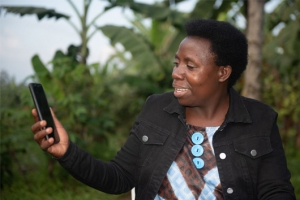The Food and Agriculture Organization (FAO)’s Digital Villages Initiative (DVI) aims to turn 1,000 villages globally into hubs where digitally-enabled farm and non-farm services are provided, such as e-commerce, farmer advisory services leveraging satellite information and digital financial inclusion activities. In Africa, nine countries are involved so far.
Scoping assessment studies and early service delivery have identified 10 success factors for rural digital transformation in Africa.
- Implementers of the DVI and similar programmes must ensure strong synergy with the development priorities of targeted localities and align with the local agriculture and socio-economic strategic frameworks. Fully onboarding local authorities is essential for sustainability and for building trust with farmers and other stakeholders.
- The local agrifood system (the web of stakeholders, relationships and activities related to the food value chain) is the target and measure of successful adoption of digital tools. Its continuous improvement is a strategic requirement so that the full potential of digital agriculture is unleashed. Issues like poor rural transport, energy supplies, and value chain deficiencies regularly impair digital agriculture service delivery.
- Ensuring suitable and affordable rural digital connectivity and access. According to the International Telecommunications Union, the urban/rural digital divide is most prevalent in Africa: only 23 per cent of rural dwellers on the continent used the internet in 2022. Governments need to further facilitate investments in digital and telecom infrastructure, including data infrastructure (database, data spaces, etc.). While community multimedia centres are still important to ensure shared and affordable access, they are not always indispensable, notable thanks to the increased social penetration of mobile phones. The global experiences of telecentre deployment have highlighted the unsustainability challenges they often face, which need to be carefully considered.
- We also need to improve capabilities in digital agriculture to address important digital skill gaps in rural areas. As exemplified by the spread of ChatGPT and other artificial intelligence tools, these technologies are permanently unveiling great new opportunities which necessitate constant upskilling. Besides farmers, in many cases, extension officers, policymakers, agro-dealers, officers in development organizations, etc., also need upskilling.
- A critical success factor is related to supporting the delivery of compelling digital agriculture services. The lack of knowledge on the complexities of agricultural value chains and not addressing the diverse needs of farmers (for example, facilitating at the same time access to agronomic tips, inputs and market linkages when needed) have often affected the effectiveness of digital solutions. Having software in local languages and commodity-specific platforms are also needed sometimes.
- Closely linked to the above is the financial sustainability of the services provided. It has been observed that smallholder farmers are often unwilling or unable to pay for digital agriculture services, particularly regarding advisory services in Africa. While subsidies are relevant in many cases, it is imperative that digital agriculture deployments become profitable and that farmers or their entities contribute to this.
- Facilitating non-farm services building on digitalization. Rural populations do not only rely on agricultural activities. Building partnerships to cater for digitally enabled health, education, or other rural economy activities to complement agrifood services provided to beneficiaries is important.
- Leveraging existing agrifood system initiatives and assets. At FAO, the DVI is building on other projects, such as the Marketing Capacity Building Project for Smallholder Farmers in Mzimba and Kasungu Districts in Malawi or the Digital Service Portfolio in Senegal.
- Strengthening engagements with rural youth and women generates many benefits. Collaboration with tech-savvy rural youth and young technology service providers helps accelerate inter-generational knowledge transfer and support quicker adoption of digitalisation. Women empowerment, on the other hand, is key, considering the important role they play in the rural economy and in reducing the gender digital divide.
- It is strongly recommended to nurture supportive ecosystem partnerships. These include building alliances with farmer organizations, local development organisations, mobile network operators, agribusinesses, etc. International players also can help expand the reach and diversity of services offered. FAO is thus working with ITU and other UN bodies in the Liberia DVI activities. Though this is very challenging to accomplish, promoting collaborative agricultural data marketplaces, and building on data services delivered by the diverse players working with farmers, will create synergy and defragment the offer of farmer services. It also helps generate innovative value-added services.
Considering these factors is very instrumental for the operation of Digital Villages or similar rural transformation initiatives that leverage digital tools to ensure success and help achieve Sustainable Development Goals.

